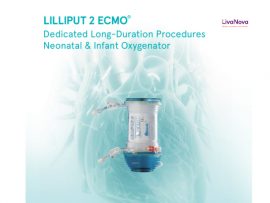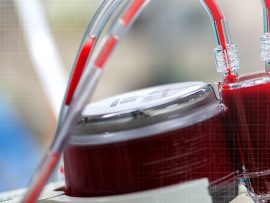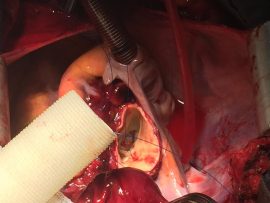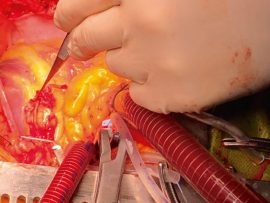Abstract Aims Knowing the upper time limit for successful weaning from temporary mechanical circulatory support in cardiogenic shock will help with decision‐making regarding advanced heart failure (HF) therapy or considering..
Lee masAbstract Background/Objectives: Previously, we showed that blood-based polarizing cardioplegia exerted beneficial cardioprotection during hypothermic ischemia; however, these positive effects of blood-based polarizing cardioplegia were reduced during normothermic ischemia compared to..
Lee masAbstract Background Management of acute aortic dissection (AAD) caused by retrograde perfusion through the femoral artery during minimally invasive cardiac surgery (MICS) remains controversial. We present a case of AAD..
Lee masAbstract Objective: Cardiopulmonary bypass (CPB) via the right axillary artery (RAA) has become an alternative perfusion strategy, especially in complex aortic procedures. This study delineates our technique and outcome with..
Lee masAbstract Background Extracorporeal cardiopulmonary resuscitation (ECPR) is increasingly used for adults with cardiac arrest (CA) refractory to Advanced Cardiovascular Life Support (ACLS). Concerns exist that adding ECPR could worsen health..
Lee masAbstract The use of extracorporeal membrane oxygenation (ECMO) has emerged as a rescue intervention for hemodynamically unstable patients and prophylactic intraprocedural hemodynamic support in the cardiac catheterization laboratory. The prompt..
Lee masAbstract The clinical tolerance of extracorporeal membrane oxygenation (ECMO) membrane changes in acute respiratory distress syndrome (ARDS) patients under veno-venous ECMO (VV-ECMO) has not been reported. The aim of this..
Lee masAbstract Cardiogenic shock represents a critical condition in which the heart is unable to maintain adequate circulation leading to insufficient tissue perfusion and end-organ failure. Temporary mechanical circulatory support offers..
Lee masAbstract Objective To describe the six-month functional outcomes of patients who received extracorporeal cardiopulmonary resuscitation (ECPR) following in-hospital cardiac arrest (IHCA) in Australia. Design Secondary analysis of EXCEL registry data...
Lee masAbstract Background Children who undergo cardiac surgery may require postcardiotomy extracorporeal membrane oxygenation (ECMO). Although morbidities are considerable, our understanding of outcome determinants is limited. We evaluated associations between patient..
Lee masAbstract Background Survival for cardiac arrest remains poor, and the use of extracorporeal cardiopulmonary resuscitation (ECPR) has been suggested as a potential therapy to improve outcomes. Harefield Hospital has been performing..
Lee masAbstract Background Acute lung injury and acute respiratory failure are frequent complications of cardiogenic shock and are associated with increased morbidity and mortality. Even with increased use of temporary mechanical..
Lee masAbstract Severe accidental hypothermia can lead to cardiac arrest. The most efficient method of resuscitating and warming is by ECMO (Extracorporeal Membrane Oxygenation). While the convention is to use VA..
Lee masAbstract Over the past two decades, extracorporeal membrane oxygenation (ECMO) has been increasingly used to support critical patients with cardiac and respiratory failure who fail to respond to conventional management...
Lee masAbstract Background Lidocaine in del Nido cardioplegia solution prolongs the refractory period of cardiomyocytes, yielding a longer arrest per dose. Serum lidocaine concentrations >8 mg/L are associated with seizure and..
Lee masAbstract Four randomized trials published between 2020 and 2023 compared extracorporeal cardiopulmonary resuscitation (ECPR) to conventional cardiopulmonary resuscitation and the controversial findings of the last one, the INCEPTION trial triggered great..
Lee masAbstract Background Veno-arterial (V-A) extracorporeal membrane oxygenation (ECMO) is commonly used for patients with cardiac arrest, cardiogenic shock, or heart failure and is a life-saving technique. Computed tomography angiography (CTA)..
Lee masAbstract Extracorporeal cardiopulmonary resuscitation (ECPR) is a complex, life-saving procedure that uses mechanical support for patients with refractory cardiac arrest, representing the pinnacle of extracorporeal membrane oxygenation (ECMO) applications. Effective..
Lee masAbstract Venoarterial extracorporeal membrane oxygenation (VA-ECMO) has been utilized to treat massive pulmonary embolism (PE) accompanied by cardiac arrest or refractory cardiogenic shock. Our team opted for a femoral-femoral approach..
Lee masAbstract Objectives: Sternotomy is rarely performed for veterinary therapeutic or recovery models in quadrupeds because of difficulties with breathing, ambulation, and pain control. Central cannulation for cardiopulmonary bypass (CPB) is infrequent..
Lee masAbstract We conducted a high-risk redo mitral valve replacement through a right mini-thoracotomy without rib spreading (redo-MICS MVR) under systemic hyperkalemia combined with circulatory arrest to circumvent complications associated with..
Lee masAbstract Background Cardiac arrest in pregnancy is rare. Clinicians need to adapt management to the altered anatomy and physiology of pregnancy, and the well-being of two patients (mother and foetus)..
Lee masAbstract Objective Extracorporeal cardiopulmonary resuscitation (ECPR) utilizes veno-arterial extracorporeal membrane oxygenation (VA-ECMO) in cardiac arrest patients to reduce the risk of mortality and multiorgan dysfunction from systemic hypoperfusion. We aimed..
Lee masAbstract Extracorporeal membrane oxygenation in a venovenous configuration (VV-ECMO) is increasingly recognized as an important therapeutic option for patients with severe acute respiratory distress syndrome (ARDS). Accumulating scientific evidence as well..
Lee masAbstract This case report details a rare instance of total reversal of the pulmonary circulation (RPC) in a 56-year-old male patient on veno-arterial extracorporeal membrane oxygenation (V-A ECMO) during emergency..
Lee masAbstract Background The use of extracorporeal membrane oxygenation (ECMO) during cardiopulmonary resuscitation (ECPR) is increasing. Prehospital ECPR (PH-ECPR) for out-of-hospital cardiac arrest (OHCA) may improve both equity of access and..
Lee masAbstract Sodium bicarbonate has been used in the treatment of different pathologies, such as hyperkalemia, cardiac arrest, tricyclic antidepressant toxicity, aspirin toxicity, acute acidosis, lactic acidosis, diabetic ketoacidosis, rhabdomyolysis, and..
Lee masAbstract Study objective To evaluate the associations between high and low intraoperative time-weighted average mean arterial pressures before, during and after cardiopulmonary bypass on postoperative delirium. Design Single center retrospective..
Lee masAbstract Aim: We investigated in a single-center retrospective study early outcomes of intermittent warm blood and cold crystalloid St. Thomas cardioplegia in patients referred to CABG due to acute coronary..
Lee masAbstract Introduction Extracorporeal cardiopulmonary resuscitation (ECPR) is a treatment for refractory out-of-hospital cardiac arrest (OHCA), often due to acute coronary syndrome (ACS). However, the long-term impact of prehospital ECPR on..
Lee mas




















